SRT Marine Systems plc 4090002 Search and Rescue Locating Device AIS SART User Manual Mercury Manual v1
Software Radio Technology plc Search and Rescue Locating Device AIS SART Mercury Manual v1
User manual

Page 1
Page 1
Contents
1 - Notices .................................................................................2
1.1 - Safety warnings..................................................................2
1.2 - General notices ..................................................................2
2 - About your AIS SART .........................................................5
2.1 - About AIS...........................................................................5
2.2 - What’s in the box................................................................6
2.3 - AIS SART overview............................................................8
3 - Installation ...........................................................................9
3.1 - Installing the mounting bracket ..........................................9
4 - Operation ...........................................................................12
4.1 - Activating the AIS SART ..................................................12
4.2 - Deploying the AIS SART..................................................13
4.3 - Deactivating the AIS SART ..............................................15
4.4 - Testing the AIS SART ......................................................15
4.5 - Display of AIS SART messages on other equipment.......16
5 - Battery information ...........................................................18
5.1 - Battery replacement .........................................................18
5.2 - Transport..........................................................................18
5.3 - Disposal ...........................................................................18
6 - Troubleshooting................................................................19
7 - Specification......................................................................20

Page 2
Page 2

Notices
Page 2
Page 2
1Notices
1.1 Safety warnings
1.2 General notices
Position source
All marine Automatic Identification System (AIS) transceivers utilise a satellite based location system such as the Global Positioning
System (GPS) network.
The accuracy of a GPS position fix is variable and is affected by factors such as the antenna positioning, how many satellites are used
to determine a position and how long satellite information has been received for.
Compass safe distance
The compass safe distance of this unit is 0.2m or greater for 0.3° deviation.
When reading this manual please pay attention to warnings marked with the warning triangle shown on the left.
These are important messages for safety, installation and usage of the product.
!
This equipment must be installed and operated in accordance with the instructions provided in this manual.
!
An AIS SART is an emergency beacon and should only be activated when there is imminent danger to life. Misuse
could endanger other lives and may result in a penalty.
!
If the AIS SART has been activated for any period the battery and activation cover must be replaced. Please
contact your dealer to arrange for service and replacement of the battery and activation cover.
!
Replace the battery before the expiry date shown on the AIS SART is exceeded. This is essential to ensure the AIS
SART will operate for the required duration in an emergency situation.
!
The AIS SART contains a Lithium metal battery. Ensure that the battery is removed prior to disposal. Please refer
to local regulations for the safe disposal of the AIS SART and battery. Do not incinerate, puncture, short circuit or
attempt to recharge the battery.
!
Do not use solvents or other chemicals to clean the AIS SART. If cleaning is required use a cloth moistened with
fresh water only.
!

Notices
Page 3
Page 3
RF emissions notice
Caution: The AIS SART generates and radiates radio frequency electromagnetic energy. This equipment must be installed and
operated according to the instructions contained in this manual. Failure to do so can result in personal injury and / or malfunction of the
AIS SART.
Warranty
This product is supplied with standard warranty as defined in the accompanying warranty information.
Disposal of this product and packaging
Please dispose of the AIS transceiver in accordance with the European WEEE Directive or with the applicable local regulations for
disposal of electrical equipment.
Every effort has been made to ensure the packaging for this product is recyclable. Please dispose of the packaging in an
environmentally friendly manner.
Accuracy of this manual
The AIS transceiver may be upgraded from time to time and future versions of the AIS transceiver may therefore not correspond exactly
with this manual. Information contained in this manual is liable to change without notice. The manufacturer of this product disclaims any
liability for consequences arising from omissions or inaccuracies in this manual and any other documentation provided with this product.
Declaration of conformity
The manufacturer of this product declares that this product is in compliance with the essential requirements and other provisions of the
R&TTE directive. The declaration of conformity is provided with the product document pack.
The product carries the CE mark, notified body number and alert symbol as required by the R&TTE directive.
The product is intended for sale in the following member states: Great Britain, France, Spain, Sweden, Austria, Netherlands, Portugal,
Denmark, Norway, Belgium, Italy, Finland, Ireland, Luxembourg, Germany and Czech Republic.
!
Any attempt to tamper with or damage this product will invalidate the warranty.

Notices
Page 4
Page 4
FCC notice
This equipment has been tested and found to comply with the limits for a class B digital device, pursuant to part 15 of the FCC Rules.
These limits are designed to provide reasonable protection against harmful interference in a residential installation. This equipment
generates, uses and can radiate radio frequency energy and, if not installed and used in accordance with the instructions, may cause
harmful interference to radio communications.
This device complies with part 15 of the FCC Rules. Operation is subject to the following two conditions: (1) This device may not cause
harmful interference, and (2) this device must accept any interference received, including interference that may cause undesired
operation.
Changes or modifications not expressly approved by the party responsible for compliance could void the user's authority to operate the
equipment.
Industry Canada notice
This device complies with Industry Canada licence-exempt RSS standard(s). Operation is subject to the following two conditions:
1. This device may not cause interference, and
2. This device must accept any interference, including interference that may cause undesired operation of the device.
This Class B digital apparatus complies with Canadian ICES-003.
Le présent appareil est conforme aux CNR d'Industrie Canada applicables aux appareils radio exempts de licence. L'exploitation est
autorisée aux deux conditions suivantes :
1. L'appareil ne doit pas produire de brouillage, et
2. L'utilisateur de l'appareil doit accepter tout brouillage radioélectrique subi, même si le brouillage est susceptible d'en compromettre
le Fonctionnement.
Cet appareil numérique de la classe B est conforme à la norme NMB-003 du Canada.
WARNING: It is a violation of the rules of the Federal Communications Commission to input an MMSI that has not
been properly assigned to the end user, or to otherwise input any inaccurate data in this device.
!

About your AIS SART
Page 5
Page 5
2 About your AIS SART
2.1 About AIS
The marine Automatic Identification System (AIS) is a location and vessel information reporting system. It allows vessels equipped with
AIS to automatically and dynamically share and regularly update their position, speed, course and other information such as vessel
identity with similarly equipped vessels. Position is derived from the Global Positioning System (GPS) and communication between
vessels is by Very High Frequency (VHF) digital transmissions.
There are a number of types of AIS device as follows:
•Class A transceivers. These are similar to class B transceivers, but are designed to be fitted to large vessels such as cargo ships
and large passenger vessels. Class A transceivers transmit at a higher VHF signal power than class B transceivers and therefore
can be received by more distant vessels. They also transmit more frequently. Class A transceivers are mandatory on all vessels over
300 gross tonnes on international voyages and certain types of passenger vessels under SOLAS regulations.
•Class B transceivers. Similar to class A transceivers in many ways, but are normally lower cost due to the less stringent
performance requirements. Class B transceivers transmit at a lower power and at a lower reporting rate than class A transceivers.
•AIS base stations. AIS base stations are used by Vessel Traffic Systems to monitor and control the transmissions of AIS transceivers.
•Aids to Navigation (AtoN) transceivers. AtoNs are transceivers mounted on buoys or other hazards to shipping which transmit
details of their location to the surrounding vessels.
•AIS receivers. AIS receivers will generally receive transmissions from class A transceivers, class B transceivers, AtoNs, AIS base
stations and AIS SARTs but do not transmit any information about the vessel on which they are installed.
• AIS SART. An AIS SART is an emergency transmitter intended for use on vessels and life rafts. The AIS SART acts as a ‘locating
device’ to assist search and rescue services in locating a vessel in distress or liferaft. When activated the AIS SART regularly
transmits its GPS position in a specific emergency message to all other AIS devices in the area. All AIS SART devices have a
unique identifier set during manufacture and require no further configuration.
This product is an AIS SART.
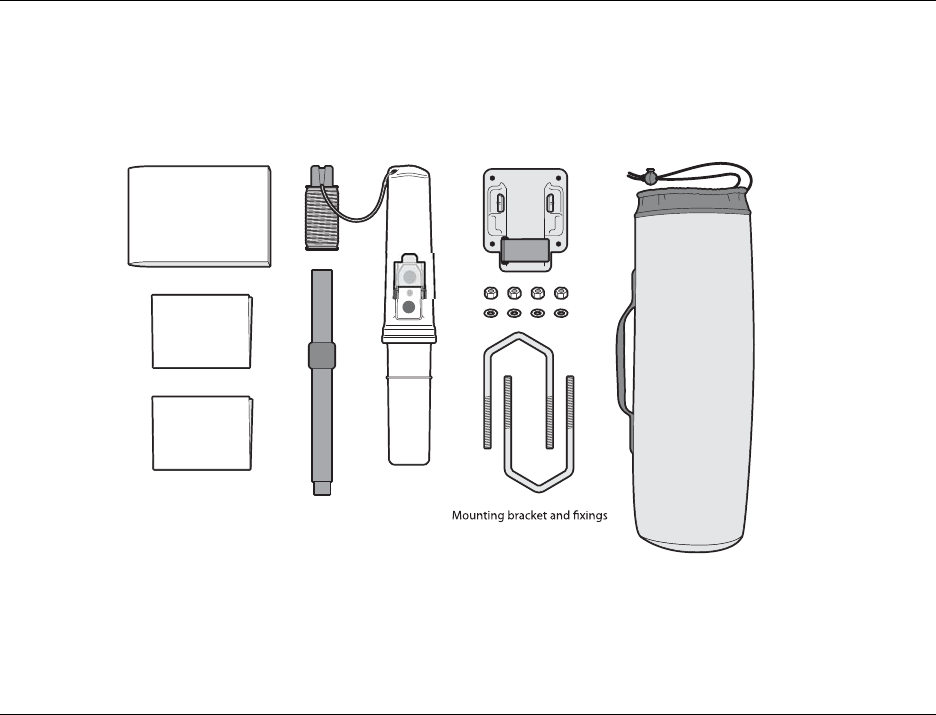
About your AIS SART
Page 6
Page 6
2.2 What’s in the box
Figure 1 shows the items included with your AIS transceiver purchase. The following sections give a brief overview of each item. Please
ensure all items are present and if any of the items are not present contact your dealer.
Figure 1 Items included with the product
Product manual
AIS SART Kit bagLanyard
Telescopic mounting pole
Warranty
information
Deployment
procedure

About your AIS SART
Page 7
Page 7
Product manual
This document is the product manual and should be read thoroughly prior to any attempt to install or use the AIS SART.
Deployment procedure
A brief graphical guide for deployment and activation of the AIS SART in an emergency situation. It is recommended this document is
stored with or near the AIS SART.
Telescopic mounting pole
The Telescopic mounting pole can be used to mount the AIS SART 1 metre above sea level when deployed on a life raft.
Lanyard
The lanyard can be used to attach the AIS SART to the canopy of a life raft, or otherwise secure the AIS SART when deployed.
AIS SART
The main AIS SART unit.
Mounting bracket and fixings
The mounting bracket can be used when mounting the AIS SART on the bridge of a vessel or when mounting on a life boat.
Kit bag
The Kit bag can be used for storage of the AIS SART, lanyard and telescopic pole when not mounted in the bracket.
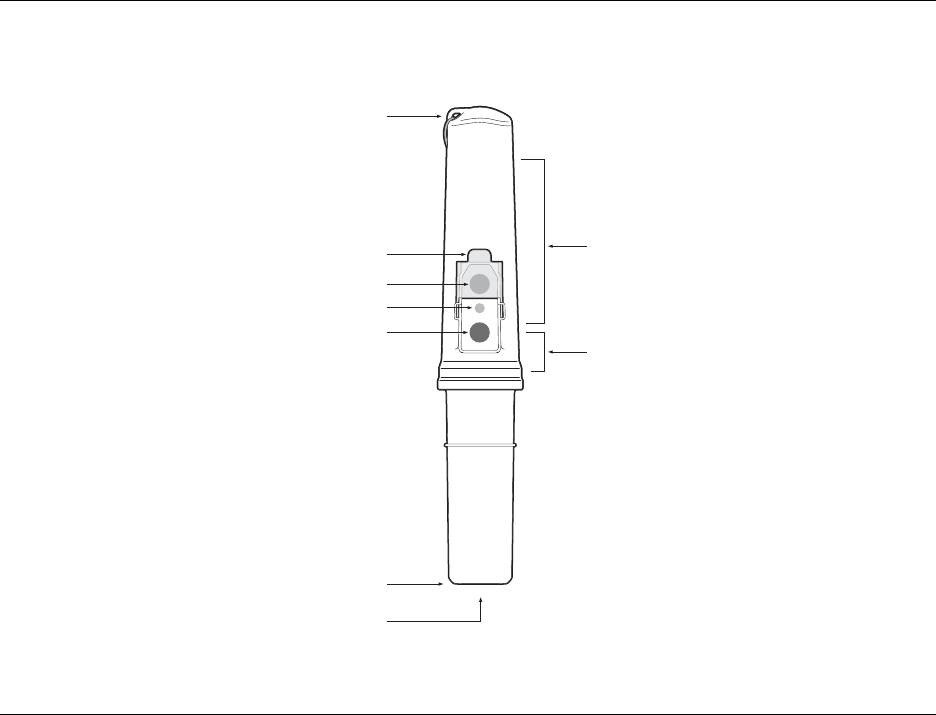
About your AIS SART
Page 8
Page 8
2.3 AIS SART overview
The main features of the AIS SART are identified in Figure 2.
Figure 2 AIS SART overview
Lanyard attachment point
Activation button
Position of VHF antenna
Position of GPS antenna
Activation cover
1 metre mark
Mounting pole socket
Test button
Status indicator

Installation
Page 9
Page 9
3 Installation
The AIS SART can be installed on a vessel or lifeboat using the supplied mounting bracket. Alternatively the AIS SART can be stored in
the supplied kit bag and kept in an abandon ship bag.
The AIS SART is fully waterproof and designed for use in the marine environment, however it is recommended that the AIS SART is
installed in a protected location.
3.1 Installing the mounting bracket
The mounting bracket can either be fixed to a vertical or horizontal pole using the supplied u-bolts, or fixed to a flat surface using
appropriate fixings (not supplied). The supplied u-bolts are suitable for use with pipe diameter from 25mm to 50mm. The bracket should
be installed in a location that can easily be reached in an emergency situation.
Figure 3 shows assembly of the AIS SART to the mounting bracket. Dimensions for the bracket mounting holes are provided in Figure 4.
To attach the AIS SART to the mounting bracket:
• Push the telescopic pole (with lanyard spool attached) into the bracket. The foam strip on the telescopic pole must align with the
recess in the bracket.
• Push the AIS SART into the mounting bracket.
• Secure the AIS SART with the velcro strap.
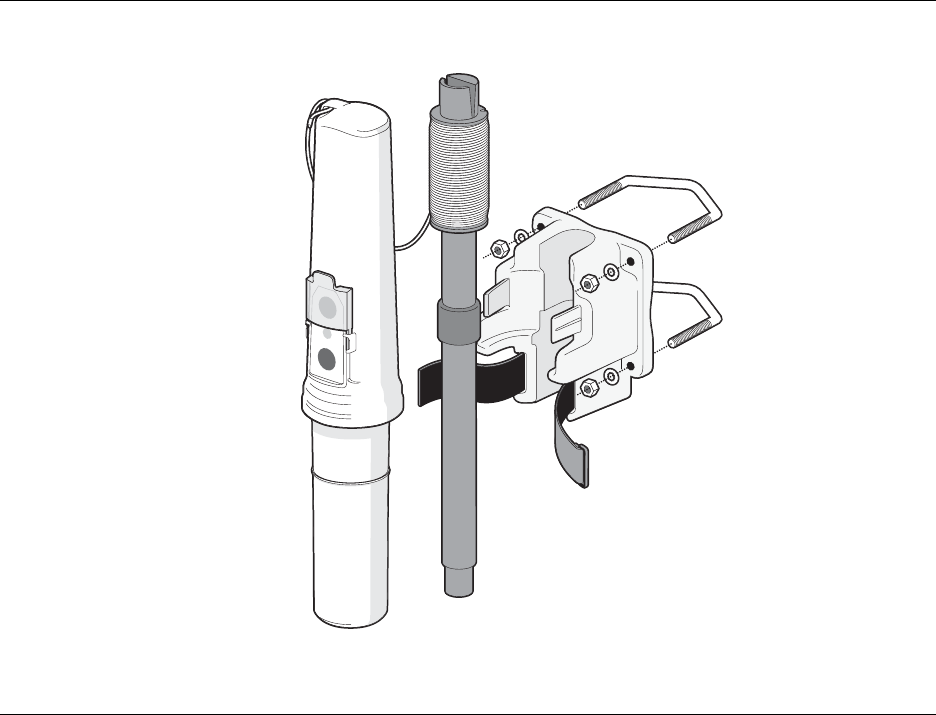
Installation
Page 10
Page 10
Figure 3 Attaching the AIS SART to the mounting bracket
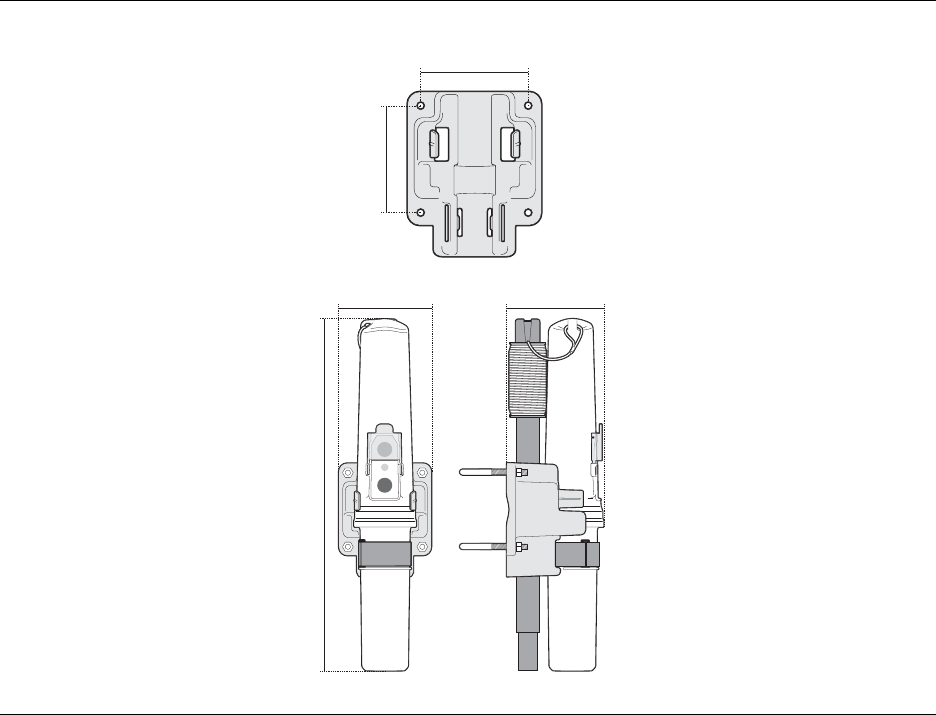
Installation
Page 11
Page 11
Figure 4 Dimensions for bracket mounting holes
Figure 5 AIS SART overall dimensions
80 mm
80 mm
100 mm
384 mm
100 mm
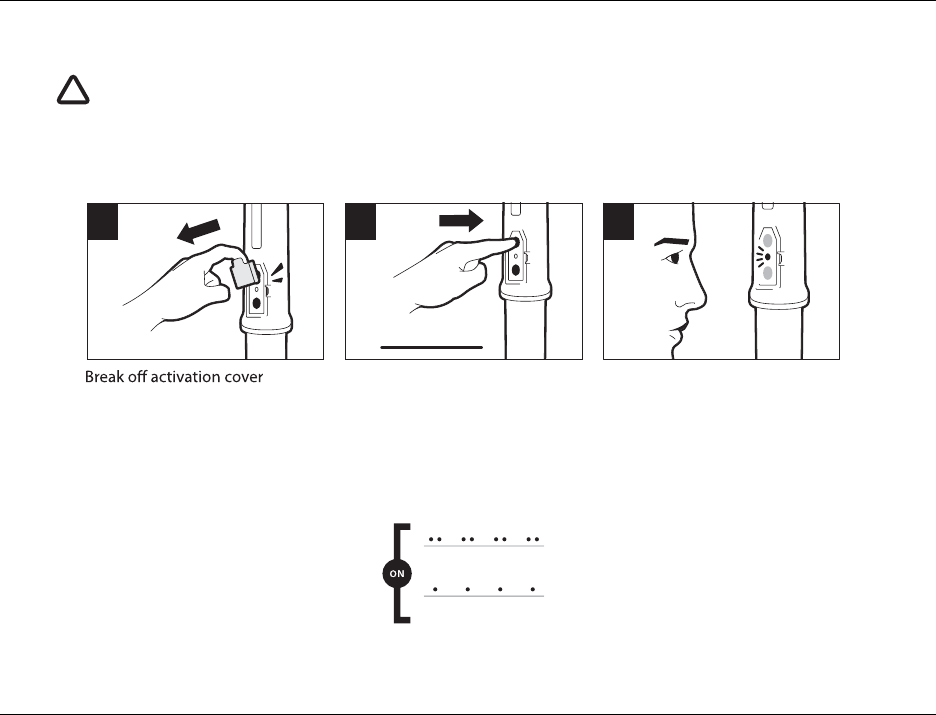
Operation
Page 12
Page 12
4Operation
4.1 Activating the AIS SART
Activate the AIS SART before deploying it on the telescopic pole or lanyard.
Figure 6 Activation procedure
• Break off the activation cover
• Press the ‘ON’ button for 3 seconds
• Check the status indicator according to Figure 7 to confirm operation
Figure 7 Status indicator in active mode
An AIS SART is an emergency beacon and should only be activated when there is imminent danger to life. Misuse
could endanger other lives and may result in a penalty.
!
Press ON to activate Check status indicator
123
1…2…3
Active, no GPS
STATUS
Active with GPS
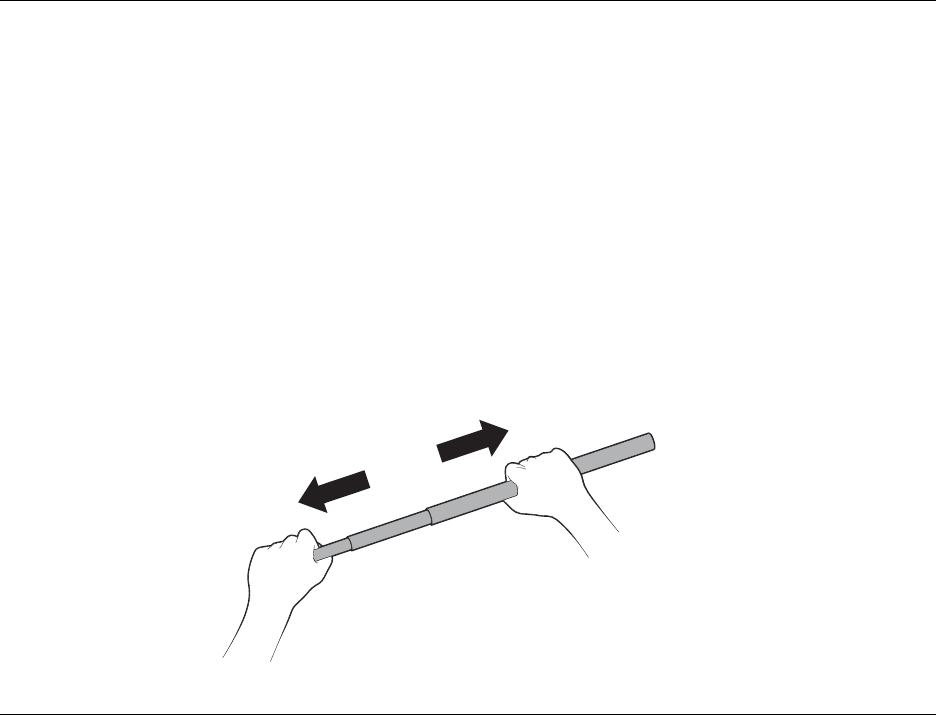
Operation
Page 13
Page 13
Once activated the AIS SART will operate for at least 96 hours. During operation the unique identifier and position of the AIS SART are
transmitted eight times per minute and a safety text message “SART ACTIVE” is transmitted every four minutes. The status indicator
shows if the AIS SART is active with or without GPS position available. Note that when initially activated it can take several minutes to
obtain an initial GPS position fix. If a GPS position fix is not obtained the AIS SART should be relocated to give the GPS antenna a clear
view of the sky. The location of the internal GPS antenna is shown in Figure 2.
4.2 Deploying the AIS SART
To ensure the best performance the AIS SART should be mounted as high as possible on the liferaft and at least one metre above sea
level. The whole body of the AIS SART should be clear of any metallic obstruction and should have a clear view of the sky.
The AIS SART should be activated before deploying on either the telescopic pole or lanyard.
Deploying outside the liferaft canopy
• Remove the lanyard spool from the top of the telescopic pole and tie the free end of the lanyard to a fixing point within the liferaft.
• Extend the telescopic mounting pole as indicated in Figure 8.
• Push the larger end of the telescopic mounting pole into the socket on the base of the AIS SART as indicated in Figure 9.
• Deploy the AIS SART through the SART opening in the liferaft.
• Place the lower end of the pole in the pocket provided in the liferaft.
• The base of the AIS-SART should be 1 metre above sea level when deployed as shown in Figure 10.
Figure 8 Extending the telescopic mounting pole
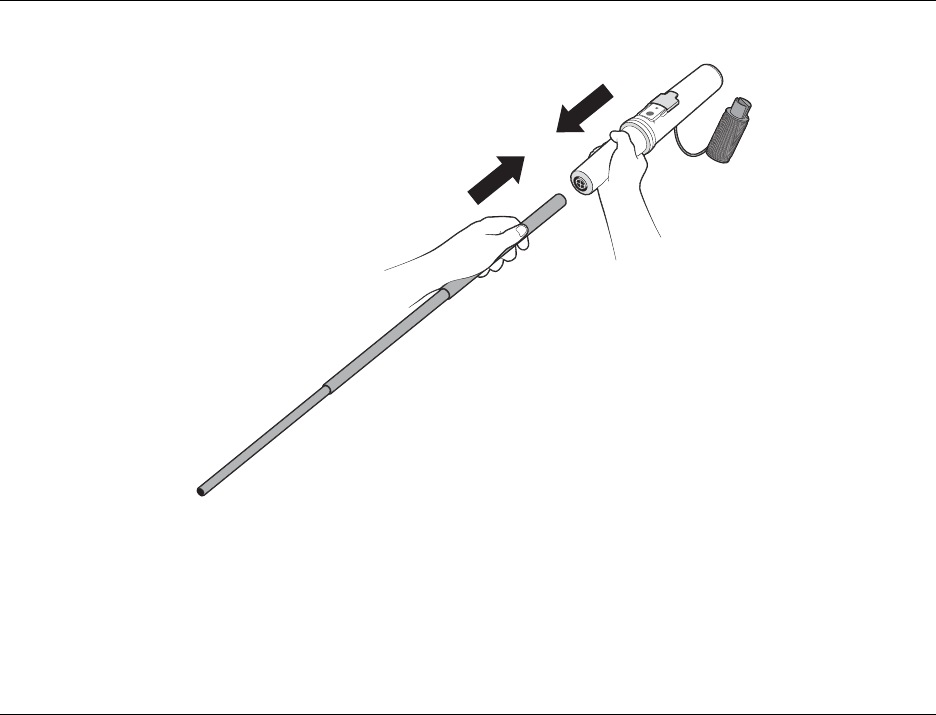
Operation
Page 14
Page 14
Figure 9 Attaching the telescopic mounting pole to the AIS SART
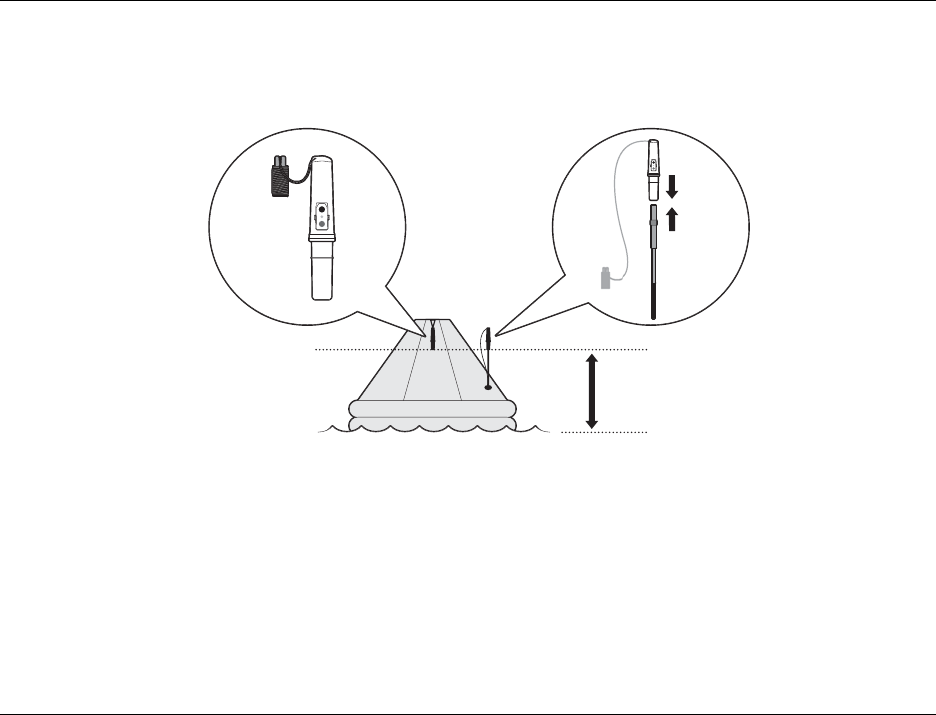
Operation
Page 15
Page 15
Deploying inside the liferaft canopy
Use the lanyard to tie the AIS SART to the highest point inside the liferaft canopy. The base of the AIS-SART should be 1 metre above
sea level when deployed as shown in Figure 10.
Figure 10 AIS SART deployment height
4.3 Deactivating the AIS SART
If the AIS SART is activated accidentally it can be deactivated by pressing and holding the test button for three seconds. The status
indicator will extinguish when the AIS SART is deactivated.
4.4 Testing the AIS SART
The AIS SART should be tested annually to confirm correct operation. In order to maximise the available battery capacity it is not
recommended to test the AIS SART more frequently. Carry out the following steps to test the AIS SART:
1. Remove the AIS SART from the bracket or bag and move to an outdoor location with a clear view of the sky. Do not hold the AIS
SART in the location marked over the internal GPS antenna.
1m
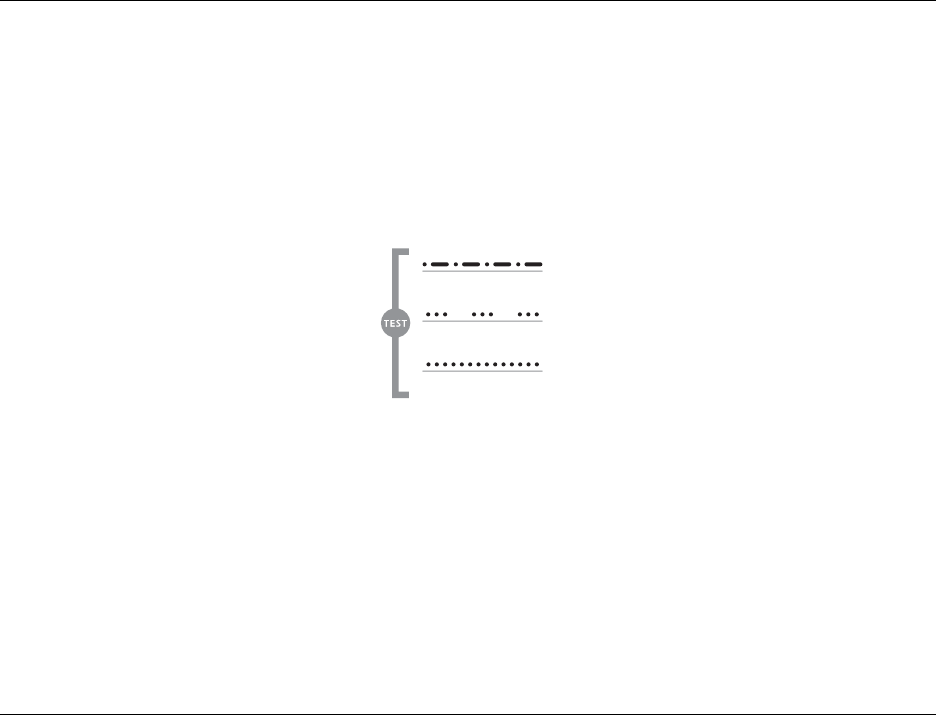
Operation
Page 16
Page 16
2. Press and hold the ‘Test’ button for three seconds until the indicator starts flashing. The test is now active and the AIS SART will
attempt to obtain a GPS position fix for five minutes.
3. The outcome of the test is indicated as shown in Figure 11. During the test AIS messages are transmitted and will be received by
all nearby vessels. Refer to section 4.5 for further information on display of AIS SART position and messages on other equipment.
4. If a pass is not indicated by the end of the test period then the AIS SART should be relocated and the test repeated.
5. If battery expiry is indicated please contact your dealer to arrange for battery replacement. Section 5 provides further details on
battery replacement.
The AIS SART test can be cancelled at any time by pressing and holding the ‘Test’ button for three seconds. The indicator will
extinguish when the test has been cancelled.
Figure 11 Status indicator in test mode
4.5 Display of AIS SART messages on other equipment
The AIS SART transmits both AIS position report and safety text messages when in active or test mode.
In active mode the text messages contain the text “SART ACTIVE” whilst in test mode the text messages contain the text “SART TEST”.
Display on Class A AIS transceiver
The display of an AIS SART on Class A AIS transceivers is dependant on the age of the Class A transceiver and / or the equipment
standard it complies with.
• Older Class A transceivers will display an AIS SART (in either active or test mode) as a vessel with MMSI matching the unique
identifier of the AIS SART. A safety related text message “SART ACTIVE” will also be displayed.
• Class A transceivers conforming to the most recent standards will display an active AIS SART at the top of the vessel list and also
output an alarm and safety related text message “SART ACTIVE”. Test messages from AIS SART devices will not be displayed
unless the AIS SART test feature is specifically enabled in the Class A equipment. Please refer to the Class A AIS transceiver
documentation for further information.
Testing
Test pass
Battery expired

Operation
Page 17
Page 17
Reception by Class B AIS transceiver
Class B AIS equipment is capable of receiving AIS SART position reports and text messages in both active and test modes. If the Class
B AIS transceiver incorporates a display a safety related message “SART ACTIVE” will be shown. However, display of the position of
the AIS SART is dependant on connection to an external chart plotter or ECS. Please refer to documentation for the connected chart
plotter or ECS for further information on display of AIS SART position reports and text messages.
Reception by AIS receiver
In most cases AIS receivers will be capable of receiving AIS SART position reports and text messages in both active and test modes.
However, as AIS receivers are not subject to certification against an international AIS standard, reception cannot be guaranteed.
Display of the position of the AIS SART is dependant on connection to an external chart plotter or ECS. Please refer to documentation
for the connected chart plotter or ECS for further information on display of AIS SART position reports and text messages.
Display on ECS / ECDIS
The display of an AIS SART on ECS / ECDIS equipment is dependant on the age of the equipment and the standard it complies with.
• Older ECS / ECDIS equipment will display an AIS SART (in either active or test mode) as a vessel with MMSI matching the unique
identifier of the AIS SART. A safety related text message “SART ACTIVE” will also be displayed.
• ECS / ECDIS equipment conforming to the most recent standards will display an active AIS SART in red with the symbol shown in
Figure 12. A safety related text message “SART ACTIVE” will also be displayed. It may be necessary to specifically enable display
of AIS SART test messages in this equipment.
Figure 12 ECDIS symbol for AIS SART (ECDIS conforming to latest standards)

Battery information
Page 18
Page 18
5 Battery information
The AIS SART contains a Lithium metal battery pack with a five year storage life. The battery expiry date is marked on the product
information label on the rear of the AIS SART.
5.1 Battery replacement
The battery must be replaced before the expiry date. Replacement is vital to ensure that the battery has sufficient capacity to operate
the AIS SART for the required 96 hours in an emergency situation. The battery must be replaced by an authorised dealer and is not user
replaceable. Any unauthorized attempt to replace the battery will invalidate any warranty provided with the AIS SART and may also
result in the AIS SART failing to operate in an emergency situation.
When the battery expiry date has passed the AIS SART will indicate battery expiry when tested (see section 4.4). Your dealer has
access to the tools required to reset the expiry date and remove this indication.
5.2 Transport
The battery contained in the AIS SART is approved for carriage on passenger aircraft in hand baggage. However, it is recommended
that the AIS SART is declared at check in.
The lithium content of the AIS SART batteries is sufficiently low for the device to fall under the ‘not restricted’ category for air cargo. To
meet this requirement the AIS SART must be packaged and handled according to the IATA Dangerous Goods Regulations (53rd
Edition, 2012), PI 970. Individual carriers may have additional requirements.
5.3 Disposal
The battery must be disposed of according to local regulations for the disposal of used batteries. Do not place in household or
commercial waste.

Troubleshooting
Page 19
Page 19
6 Troubleshooting
Issue Possible cause and remedy
The AIS SART does not pass the self test • A successful self test is reliant on the AIS SART being able to obtain a GPS
position fix. Please ensure that the AIS SART is outdoors and has a clear
unobstructed view of the sky overhead. Re-test the AIS SART.
• The battery is depleted; please contact your dealer to arrange for
replacement.
AIS SART test messages are not displayed
on other equipment • Please refer to section 4.5 for further information on the display of AIS SART
position reports and text messages on other equipment.
• Check that the display equipment is configured to display test messages from
AIS SART.
• Note that the AIS SART may be displayed as a vessel on some equipment.
Check for display of a vessel with MMSI matching the unique identifier of the
AIS SART
• Ensure that the AIS SART is not located near any large metallic structures
than may affect the VHF transmissions
Battery expiry is indicated during self test • Please contact your dealer to arrange for service and battery replacement
The status indicator does not illuminate or
flash when the test button is pressed • The battery is depleted; please contact your dealer to arrange for
replacement.

Specification
Page 20
Page 20
7 Specification
Parameter Value
Dimensions (AIS SART only) 384mm x 68mm (max. diameter)
Dimensions (Max. stowed in bracket) 100 x 100 x 384mm (L x W x H)
Weight (AIS SART only) 330g
Weight (stowed in bracket) 650g
Operating temperature range -20°C to +55°C
Storage temperature range -30°C to +70°C
Water ingress protection IPx6 and IPx8
Compass safe distance XXX
Operating life when active 96 hours at -20°C
AIS transmitter frequency 161.975MHz (AIS1) and 162.025MHz (AIS2)
AIS transmitter power output 1W EIRP
Battery 1500mAh Lithium metal, 5 year shelf life.
GPS receiver 48 channel with typical time to first fix of 35 seconds
Relevant technical standards AIS SART - IEC61097-14
AIS and Radio - ITU-R M.1371-4
GPS - IEC61108-1
Environmental - IEC60945
IMO MSC.246(83)